| Pages:
1
2 |
XeonTheMGPony
International Hazard
    
Posts: 1640
Registered: 5-1-2016
Member Is Offline
Mood: No Mood
|
|
Recent bromine synth
Following Magpies method doubled up, I made some crude bromine : http://www.sciencemadness.org/talk/viewthread.php?tid=13104
After a basic washing in sulfuric acid, I proceeded to use a 20Ml syringe with a 16 gauge needle to fill some Kimberly Pre-scored 10Ml Ampules
To start I made an ampule holder by taking a small chunk of 2*6 and bored 4 * 3/4" holes with a hole saw and drill press.
I pre-loaded the holder with some damaged ampules (the stems) and placed out side to cool along with the syringe.
Then proceeded to charge the ampules with slightly over 10Ml of Bromine.
Due to the damaged stems on some they failed to seal, ampules can be a pain to open, to facilitate safe opening I used my ampule holder and a 11mm
deep socket to snap the neck, then used the syringe to transfer it to the new ampule and seal with a propane turbo torch.
Big part of the issue is I failed to clean it more thoroughly after wards with clean sulfuric acid, this caused some residue to contaminate the stem
making sealing more difficult.
The chilling helped allot with the sealing of the ampules.
I weighted them out by placing a blank ampule on the scale and turned it on, then weighed and recorded the weights on them.
I then stored them in a sealed plastic polypropylene container on a bed of sodium bicarbonate separated with tissue paper.
Sadly one ampule that had been charged shattered in my hand, thankfully was wearing PVC gloves, they prevented any of it getting on my hands with time
to remove them.
The massive fumes had caused sever irritation to the eyes, so flushed with a bicarb solution till the burning had stopped, thank fully was wearing my
3m mask with halogen gas rated cartridges.
But due to the syringe vs pippet and the ampule holder had made the process way easier vs the free hand method, deep chilling helped cut the fuming
down by a great deal.
Synopsis:
- Spend much more time on post work up cleaning of the Bromine
- Pre-cleaning the ampule necks with alcohol would have helped
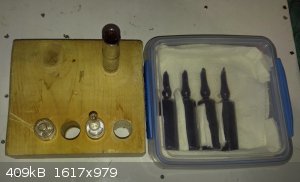 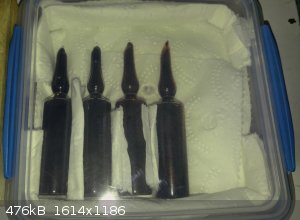 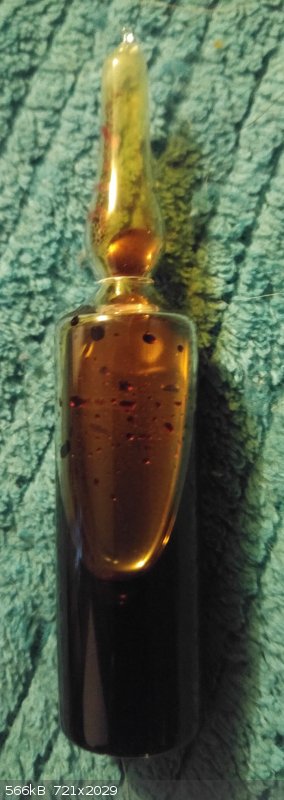 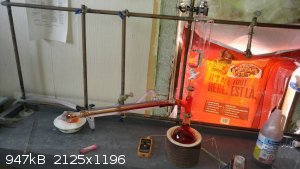 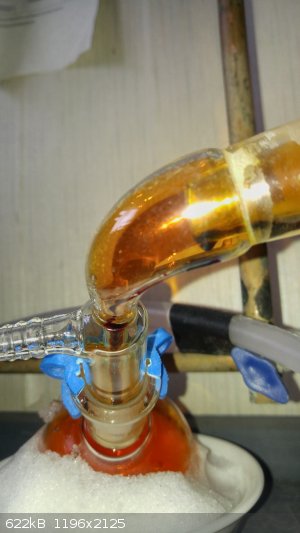
[Edited on 6-1-2019 by XeonTheMGPony]
[Edited on 6-1-2019 by XeonTheMGPony]
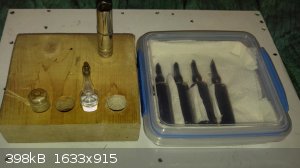
|
|
|
lordcookies24
Hazard to Self
 
Posts: 78
Registered: 2-1-2019
Location: pluto
Member Is Offline
Mood: curious
|
|
this isn't to insult your lab skills but this scares the hell out of me.
btw can you u2u me images of your heating mantle, we already talked about it on another thread.
|
|
|
XeonTheMGPony
International Hazard
    
Posts: 1640
Registered: 5-1-2016
Member Is Offline
Mood: No Mood
|
|
Quote: Originally posted by lordcookies24  | this isn't to insult your lab skills but this scares the hell out of me.
btw can you u2u me images of your heating mantle, we already talked about it on another thread. |
Scary? Again never fear that with which you work, respect it but if you're scared of some thing study it more befor handling it.
You won't be needing any thing like Bromine till you get much further along, by then you'll be more comfortable with toxic or corrosive or both
substances.
Healthy caution is good.
The accident I described can happen to any one or thing no matter the precautions you take, but it is thanks to the precautions and safety plan the
only resualt of it was me being annoyed at lost product and some minor irritation to the eyes despite having the glasses on.
And the most important thing is not panicking.
I did my filling out side due to it being winter at -6c ideal for the task.
On seeing the ampule had shattered and my glove covered hand was saturated in the Bromine, I took off the glove then checked to ensure non bled
through and contacted the skin and non was on my clothing, then quickly contain the immediate mess.
Then go inside the house and remove mask and glasses, rinsed out eyes with distilled water, then Bicarb till all irritation had ceased, then a final
distilled water rinse (Overkill, but when working with halogen gasses it is best to have an over abundance of caution)
I then returned out side and dusted the contaminated area of snow with Sodium Bi Carbonate.
[Edited on 7-1-2019 by XeonTheMGPony]
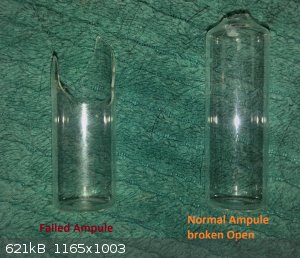
|
|
|
MrHomeScientist
International Hazard
    
Posts: 1806
Registered: 24-10-2010
Location: Flerovium
Member Is Offline
Mood: No Mood
|
|
This is a good lesson in safety. XeonTheMGPony researched this procedure and knew exactly what type of protective gear to use BEFORE starting the
experiment (gas mask RATED for halogens, & the particular type of gloves resistant to the chemical you're working with). When an accident
happened, he didn't panic and calmly enacted safety and cleanup procedures he had also pre-planned before running the reaction. You've got to know
exactly what you're getting into when handling chemicals, so you know what to do when things go wrong.
It's really great to see a new member so excited about chemistry, lordcookies24! I know you want to get started right away, but please stop and take
some time to research safety before starting a new experiment. Just remember how dangerous this hobby can be; not just for yourself but for your
neighbors too!
|
|
|
lordcookies24
Hazard to Self
 
Posts: 78
Registered: 2-1-2019
Location: pluto
Member Is Offline
Mood: curious
|
|
Quote: Originally posted by MrHomeScientist  | This is a good lesson in safety. XeonTheMGPony researched this procedure and knew exactly what type of protective gear to use BEFORE starting the
experiment (gas mask RATED for halogens, & the particular type of gloves resistant to the chemical you're working with). When an accident
happened, he didn't panic and calmly enacted safety and cleanup procedures he had also pre-planned before running the reaction. You've got to know
exactly what you're getting into when handling chemicals, so you know what to do when things go wrong.
It's really great to see a new member so excited about chemistry, lordcookies24! I know you want to get started right away, but please stop and take
some time to research safety before starting a new experiment. Just remember how dangerous this hobby can be; not just for yourself but for your
neighbors too! |
I did have some safety measures like a having a solution of sodium bicarbonate to neutralize the sulfuric acid in a worst case scenario. But I was
just using sulfuric acid and sugar, not handling an extremely toxic halogen. I don't think I actually inhaled the SO2. I just wanted to know about how
efficient a gas mask was against small compounds
|
|
|
XeonTheMGPony
International Hazard
    
Posts: 1640
Registered: 5-1-2016
Member Is Offline
Mood: No Mood
|
|
Very efficient, so long as it is a proper rated Cartridge, I have basic organic vapor cartridges for the average solvents as they are cheaper and
lighter (For the cost of them I recommend not buying any thing less then these!), and I have my
halide gasses cartridges, expensive and heavy (Buy a set of these and keep them in a sealed jar and use them
when ever working with Cl, Br, HF, and other such nasties) .
https://www.latoplast.com/north-gas-and-vapour-cartridges
Now remember, cartridges do not protect you in super high concentrations, but they allow you time to calmly escape the area. When the ampule shattered
I had strong odor of Bromine despite having the mask on (I expected as much due to experience working with halogen gasses and wearing such equipment)
This is important to understand to prevent panic.
Under moderate levels they will efficiently remove all but a trace, as they wear out the smell will get stronger over time, it is up to you when to
replace the cartridge, for me that is when there is enough to irritate my nose. (They are pricey but hell of a lot more cheaper then a lung
transplant!)
Get into the practice of cleaning your mask and caring for it, washing in warm soapy water (After removing the cartridges) and rinsing drying,
lubricate any thing that requires it with the recommended lubricant, store in a tupper wear container along with your cartridges. Assemble and test be
for use. House hold Ammonia water is good for this, with mask on you shouldn't smell much of any thing.
Replace the cartridges once a year is usually a safe bet, but if used allot replace when you can start smelling the gas you're working with strongly
or it is enough to irritate the nose.
When working with sulfuric acid make a saturated solution of sodium bicarbonate up in 2 * 4L milk jugs and 1 Jug plain water.
If you ever get it on you, use plain water first, to dilute, then the bicarbonate to neutralize, other wise the neutralization reaction can cause
damage too from heat! Eyes and Face first and for most, then groin, then rest of body.
[Edited on 7-1-2019 by XeonTheMGPony]
[Edited on 7-1-2019 by XeonTheMGPony]
|
|
|
MrHomeScientist
International Hazard
    
Posts: 1806
Registered: 24-10-2010
Location: Flerovium
Member Is Offline
Mood: No Mood
|
|
Good to know. Make sure you have enough to neutralize everything! Concentrated acid would take quite a lot of bicarbonate; you might be better off
with a big bag of the solid powder, in this case.
Gas masks only work for the things their filters are rated for, so you'd likely need special cartridges for that. If it's just rated for dust
particles, it won't do anything against gases.
I know safety lectures get tuned out after a while. I do it too. But it's hard to stress it enough with this hobby. We have at least one confirmed
death of a member on this forum. That's not something I want to see happen ever again.
|
|
|
morganbw
National Hazard
   
Posts: 561
Registered: 23-11-2014
Member Is Offline
Mood: No Mood
|
|
Quote: Originally posted by MrHomeScientist  | Good to know. Make sure you have enough to neutralize everything! Concentrated acid would take quite a lot of bicarbonate; you might be better off
with a big bag of the solid powder, in this case.
Gas masks only work for the things their filters are rated for, so you'd likely need special cartridges for that. If it's just rated for dust
particles, it won't do anything against gases.
I know safety lectures get tuned out after a while. I do it too. But it's hard to stress it enough with this hobby. We have at least one confirmed
death of a member on this forum. That's not something I want to see happen ever again. |
I was thinking about this myself, there are a few edge cases that will put us dead without even knowing what was going on.
I firmly believe that we need to research any reaction we are doing and know what might leap out and bite.
Sadly, I believe, that the individual that that was mentioned that died got exactly the product he was after, a case of not understanding the danger.
|
|
|
XeonTheMGPony
International Hazard
    
Posts: 1640
Registered: 5-1-2016
Member Is Offline
Mood: No Mood
|
|
Quote: Originally posted by MrHomeScientist  | Good to know. Make sure you have enough to neutralize everything! Concentrated acid would take quite a lot of bicarbonate; you might be better off
with a big bag of the solid powder, in this case.
Gas masks only work for the things their filters are rated for, so you'd likely need special cartridges for that. If it's just rated for dust
particles, it won't do anything against gases.
I know safety lectures get tuned out after a while. I do it too. But it's hard to stress it enough with this hobby. We have at least one confirmed
death of a member on this forum. That's not something I want to see happen ever again. |
For personal contamination this can actually cause injury, when neutralizing acid on skin you want dilute solution to keep the heat of reaction low
Especially for the eye's, I used one tea spoon (Ya ya empirical measures yadda yadda!) bicarb to 250ml water, nice and gentle.
[Edited on 7-1-2019 by XeonTheMGPony]
|
|
|
Abromination
Hazard to Others
  
Posts: 432
Registered: 10-7-2018
Location: Alaska
Member Is Offline
Mood: 1,4 tar
|
|
Another good piece of advice, especially for people like me who have a bit less hands on experience or a lack of good aparatus: If you feel
uncomfortable with a progect or experiment, a feeling that you wont be safe doing it or will put others in danger, reconsider.
List of materials made by ScienceMadness.org users:
https://docs.google.com/spreadsheets/d/1nmJ8uq-h4IkXPxD5svnT...
--------------------------------
Elements Collected: H, Li, B, C, N, O, Mg, Al, Si, P, S, Fe, Ni, Cu, Zn, Ag, I, Au, Pb, Bi, Am
Last Acquired: B
Next: Na
-------------- |
|
|
clearly_not_atara
International Hazard
    
Posts: 2787
Registered: 3-11-2013
Member Is Offline
Mood: Big
|
|
Quote: Originally posted by MrHomeScientist  | | This is a good lesson in safety. XeonTheMGPony researched this procedure and knew exactly what type of protective gear to use BEFORE starting the
experiment (gas mask RATED for halogens, & the particular type of gloves resistant to the chemical you're working with). When an accident
happened, he didn't panic and calmly enacted safety and cleanup procedures he had also pre-planned before running the reaction. You've got to know
exactly what you're getting into when handling chemicals, so you know what to do when things go wrong. |
qfe!
|
|
|
hacker
Harmless

Posts: 34
Registered: 18-12-2018
Member Is Offline
|
|
Cool 
I am about to make a tiny amount of bromine. I will use BCDMH and sodium metabisulfite.
|
|
|
XeonTheMGPony
International Hazard
    
Posts: 1640
Registered: 5-1-2016
Member Is Offline
Mood: No Mood
|
|
Go slow and steady and sure to succeed! Don't skimp on ice, it helps but there will still be a lot of fuming. Have some Bicarbonate solution on hand
as well.
Look forward to seeing the resualt!
|
|
|
Thechemguuy
Harmless

Posts: 2
Registered: 8-1-2019
Member Is Offline
|
|
Bromine
I can tell you guys I have had my worst and only chemistry „accident” with bromine.And it was horrific.I wasn’t aware of the reaction being so
exothermic and suddenly bromine vapors were shooting out of the apparatus and some of my glass apparatus broke due to the pressure of the bromine
vapors in the apparatus.Me as a very unexperienced chemist had nothing like thiosulfate or any other reducing agents on hand and my gas mask helped
but not that long since the bromine vapors were to much for it to handle.
In hindsight I should’ve spent way more time thinking about bad outcomes and things that could go wrong and how to prevent and deal with them.Stay
safe
[Edited on 8-1-2019 by Thechemguuy]
|
|
|
XeonTheMGPony
International Hazard
    
Posts: 1640
Registered: 5-1-2016
Member Is Offline
Mood: No Mood
|
|
Quote: Originally posted by Thechemguuy  | I can tell you guys I have had my worst and only chemistry „accident” with bromine.And it was horrific.I wasn’t aware of the reaction being so
exothermic and suddenly bromine vapors were shooting out of the apparatus and some of my glass apparatus broke due to the pressure of the bromine
vapors in the apparatus.Me as a very unexperienced chemist had nothing like thiosulfate or any other reducing agents on hand and my gas mask helped
but not that long since the bromine vapors were to much for it to handle.
In hindsight I should’ve spent way more time thinking about bad outcomes and things that could go wrong and how to prevent and deal with them.Stay
safe
[Edited on 8-1-2019 by Thechemguuy] |
Why I stress to people start nice and slow, it isn't a race but a journey, the faster you go the faster you F-up, and once you lose control it is very
hard to get back in most cases.
Thanks for sharing of the experience!
|
|
|
hacker
Harmless

Posts: 34
Registered: 18-12-2018
Member Is Offline
|
|
I made 9.5 mililiters of crude bromine in a trial run. I followed the method of len1 with BCDMH at a 25% scale. I went very slowly. The bromine is
wet. It may contain hydrogen bromide and chlorine. I will purify the bromine after I make more.
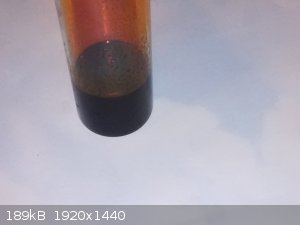
|
|
|
MrHomeScientist
International Hazard
    
Posts: 1806
Registered: 24-10-2010
Location: Flerovium
Member Is Offline
Mood: No Mood
|
|
Nice work! I was pretty proud when I made bromine myself. It's almost a rite of passage for amateur chemists: make a very unique element from mostly
common pool chemicals!
I dried mine by shaking with concentrated sulfuric acid (a pretty scary procedure, when you think about it). I would think the HBr would leave with
the water. I avoided chlorides in my procedure to sidestep that contamination issue; I think it's very hard to separate them out and I have little
advice there.
It's great to see new people coming in and experimenting!
Oh, and great point about dilute solutions, Xeon. I was thinking a big bag more for spills on the floor, to neutralize large volumes. If it's on your
skin and eyes, dilute is the way to go. With concentrated sulfuric acid, you want to rinse with a ton of water because it makes a LOT of heat, so you
could get thermal as well as chemical burns.
|
|
|
XeonTheMGPony
International Hazard
    
Posts: 1640
Registered: 5-1-2016
Member Is Offline
Mood: No Mood
|
|
Quote: Originally posted by MrHomeScientist  | Nice work! I was pretty proud when I made bromine myself. It's almost a rite of passage for amateur chemists: make a very unique element from mostly
common pool chemicals!
I dried mine by shaking with concentrated sulfuric acid (a pretty scary procedure, when you think about it). I would think the HBr would leave with
the water. I avoided chlorides in my procedure to sidestep that contamination issue; I think it's very hard to separate them out and I have little
advice there.
It's great to see new people coming in and experimenting!
Oh, and great point about dilute solutions, Xeon. I was thinking a big bag more for spills on the floor, to neutralize large volumes. If it's on your
skin and eyes, dilute is the way to go. With concentrated sulfuric acid, you want to rinse with a ton of water because it makes a LOT of heat, so you
could get thermal as well as chemical burns. |
Yup why I all ways advise any one working with the stuff to have two plain water 4l jugs and 2 bicarb solution jugs, water rinse, then bicarb rinse,
bicarb rinse, then water rinse, as even NaHCO3 can be irritating to areas
Even for spills on a desk and stuff, all ways start with dilute and work your way up, as a violent reaction just makes things worse from gas evolution
to heat and spattering, all ways maintain control of the reaction.
More ideal is a portable shower with a weak base solution in it My lab is next to the washroom at home and I put a ball valve on the shower nozzle, so
when doing high risk stuff I set water temp and then shutter the ball valve and leave a clear path to it and tie the curtain back.
5 seconds or less I can be in that shower with water running even if blinded (Ideally temporarily, best not at all!)
And I have a powder extinguisher right on the door and a 2 pound halon unit floating about.
All ways stop and think of the worst case scenario, and how you can deal with it as rapidly as possible, rehears the plan a few times be for the lab
work, when that Adrenalin hits your body remembers more so then the brain.
If your lab is remote from the house get a portable camping shower, fill it with a mild sodium bicarbonate solution and keep it set up and ready.
|
|
|
outer_limits
Hazard to Others
  
Posts: 139
Registered: 3-3-2020
Member Is Offline
Mood: hybridized
|
|
Made some bromine for fun today.
One thing that wasn't funny was the yield, slightly above 50%.
I think I've ended distillation too early and another reason could be insufficient cooling (short condenser and not so much ice in the bucket).
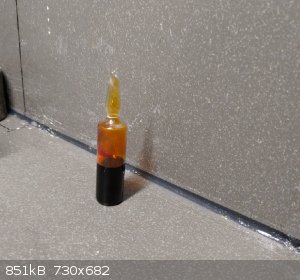 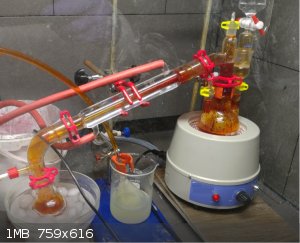
|
|
|
woelen
Super Administrator
        
Posts: 8012
Registered: 20-8-2005
Location: Netherlands
Member Is Offline
Mood: interested
|
|
Nice ampoule of bromine. Good to see that you managed to make this.
The yield of 50% is not excellent, but it is quite OK for home use. Now at least you have a nice element collector's item.
|
|
|
outer_limits
Hazard to Others
  
Posts: 139
Registered: 3-3-2020
Member Is Offline
Mood: hybridized
|
|
I was somehow scared about making bromine. But it was also a good test of hood and ventilation system. No smell of bromine after disassembling the
apparatus convinced me that I can make real chemistry in reasonable scale without fear 
[Edited on 23-4-2020 by outer_limits]
|
|
|
draculic acid69
International Hazard
    
Posts: 1371
Registered: 2-8-2018
Member Is Offline
|
|
Quote: Originally posted by outer_limits  | Made some bromine for fun today.
One thing that wasn't funny was the yield, slightly above 50%.
I think I've ended distillation too early and another reason could be insufficient cooling (short condenser and not so much ice in the bucket).
|
I use the uc235 method https://m.youtube.com/watch?v=AL9ehxTaYRs
It gives a 90-95% yeild of br2
|
|
|
outer_limits
Hazard to Others
  
Posts: 139
Registered: 3-3-2020
Member Is Offline
Mood: hybridized
|
|
I used KBr/H2SO4/H2O2 method which should also give reasonable yield. But as I mentioned, I've messed up few things which I will improve in next
attempt.
|
|
|
Texium
|
Thread Moved
23-4-2020 at 08:36 |
Shiva_Inorganic
Harmless

Posts: 12
Registered: 15-3-2018
Member Is Offline
Mood: No Mood
|
|
Instead of KBr, KBrO3 can be used to prepare Bromine in vapour form. This route doesn't require distillation or heating.
Using this method:-
1. You can prepare strong & pure Bromine water
2. You can conduct experiments in Bromine atmosphere.
You may find this useful
https://www.youtube.com/watch?v=265XlnTWkcM
- Shiva Chemist
|
|
|
Texium
Administrator
       
Posts: 4580
Registered: 11-1-2014
Location: Salt Lake City
Member Is Offline
Mood: PhD candidate!
|
|
Quote: Originally posted by outer_limits  | I used KBr/H2SO4/H2O2 method which should also give reasonable yield. But as I mentioned, I've messed up few things which I will improve in next
attempt.
|
Yeah, better cooling should result in a much higher yield. I have gotten up to 84% yield using the same
method, but I use a very efficient Graham condenser.
|
|
|
| Pages:
1
2 |